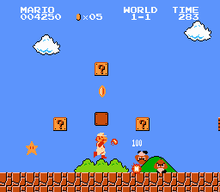Platformer
Platform game, also called platformer, is a computer and video game genre characterised by the player having to climb up and down, or jump from and to, platforms and ledges, while fighting enemies and collecting objects required to fully complete the game. Often, the player has the ability to gain powers or weapons, called power-ups. Generally, platform games, due to their unrealistic nature, have cartoon-like graphics, and with the recent advent of cel-shaded animation may appear to be hand-drawn; in addition, platformers' characters are usually legendary or invented creatures (e.g. dragons and goblins).
Platform games originated in the early 1980s and made the transition to 3D in the mid-1990s. Sometime after the genre's inception, the term came to describe games where jumping on platforms, as opposed to shooting, was the main gameplay focus. However, many platform games feature projectile weapons, including the Mario and Castlevania franchises.
Platform games are one of the most well-known types of video game outside the gaming community, which could be the reason games based on movies, television shows, and comic books tend to be of the platform variety.
History

The 2D era
Platform games appeared in the early 1980s, when video game consoles weren't yet powerful enough to render 3D games. They scrolled from left rightward, with the playable character viewed from a side angle. The protagonist climbed up and down ladders or jumped from platform to platform, often while combating foes and collecting power-ups. The first game of this kind is Donkey Kong, an arcade game created by Nintendo, released in 1981. Soon enough, level advancement changed from being mainly vertical to largely horizontal, Pitfall!, released by Activision for the Atari 2600 in 1982, considered by many to have started the trend.
Nintendo's Super Mario Bros., released for the Nintendo Entertainment System in 1985, spawned a revolution not only in the platform game genre, but in the video game industry as a whole. It introduced players to huge and intricate worlds and set a precedent in gameplay and level design for other game developers to follow, and the game remained long unsurpassed by other productions (still considered by many to be the finest platform game ever). Its popularity was unprecedented, and its record sales of 40.23 million copies worldwide is still unmatched. The game was for many the first experience of a platformer and solidified Mario's position as Nintendo's mascot.
The 3D era
Though Super Mario 64 released for the Nintendo 64 in 1996 was not the first 3D platform game, it redefined the genre and became the landmark game which set the rules for following titles of the type (such as the free camera and the central hub for access to levels).
Other successful series of 3D platform games include Crash Bandicoot and Spyro the Dragon, both for the Sony PlayStation.
This section needs expansion. You can help by adding to it. |
Chronology of significant platform games
- Donkey Kong (Nintendo, 1981) - first game featuring Mario (although named Jumpman at the time)
- Space Panic (Universal, 1982)
- Pitfall! (Activision, 1982)
- Miner 2049er (Big Five Software, 1982)
- Jumpman (Epyx, 1983)
- Manic Miner (Bug-Byte, 1983)
- Chuckie Egg (A'n'F, 1983)
- Monty on the Run (Gremlin Graphics, 1985) - ZX Spectrum & CBM 64 classic
- Super Mario Bros. (Nintendo, 1985) - perhaps most widely known platformer; best-selling game of all time
- Mega Man (Rockman) (Capcom, 1987)
- Haunted Castle (Konami, 1988) - predecessor of the Castlevania series
- Captain Comic (Michael Denio, 1988) - possibly first IBM PC platformer
- Prince of Persia (Brøderbund, 1989)
- Super Mario Bros. 3 (Nintendo, 1990) - highest grossing console game before Pokémon
- Commander Keen (id Software, 1990) - first major IBM PC platformer
- Sonic the Hedgehog (Sega, 1991) - first platformer widely considered to be a rival to Mario series
- Earthworm Jim (Shiny Entertainment, 1994)
- Donkey Kong Country (Rareware, 1994) - featured revolutionary computer generated graphics
- Super Mario 64 (Nintendo, 1996) - first truly 3-dimensional platform game
